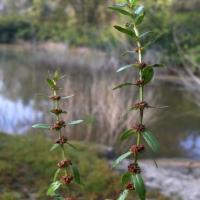Monarch redstem
Ammannia baccifera
Ammannia baccifera, commonly known as amaranthus redstem, is a herbaceous plant species belonging to the family Lythraceae. It is native to various parts of Asia, Africa, and Australia, and it is often found in wetland habitats, including marshes, swamps, and the margins of rivers and lakes. Here is a description of Ammannia baccifera:
Appearance:
- Ammannia baccifera is a perennial or annual herb that can vary in size depending on its growing conditions.
- The plant typically has a reddish stem, which gives it its common name "amaranthus redstem." However, stem color can also vary from green to reddish-brown.
- The leaves are simple, opposite, and lance-shaped, with a green to reddish coloration.
- The flowers of amaranthus redstem are small and inconspicuous, typically pink to reddish in color, and arranged in clusters or spikes.
- The fruit of the plant consists of small, spherical capsules containing seeds.
Habitat:
- Ammannia baccifera is primarily a wetland plant and is commonly found in aquatic or semi-aquatic environments.
- It thrives in areas with standing water, such as marshes, swamps, the edges of ponds and lakes, and slow-moving streams.
- It can tolerate both submerged and emergent growth conditions.
Lifecycle:
- Ammannia baccifera can be either an annual or perennial plant, depending on its growing conditions and geographic location.
- It reproduces both by seed and vegetatively through the growth of rhizomes, allowing it to spread and form dense colonies in suitable wetland habitats.
Ecological Impact:
- In its native range, amaranthus redstem plays a role in wetland ecosystems, providing habitat and food for various aquatic and semi-aquatic species.
- In some regions where it has been introduced or become invasive, it can form dense stands that may outcompete native wetland vegetation, potentially altering local ecosystems.
Control:
- Control measures for ammannia baccifera in wetland environments may include manual removal, mechanical or physical control methods, and, in some cases, the use of approved herbicides.
- Managing the plant's spread and preventing its establishment in new areas is crucial to minimizing its potential impact on native wetland ecosystems.
The presence of Ammannia baccifera in wetland habitats can be ecologically significant, as it contributes to the overall biodiversity of these ecosystems. However, it is essential to monitor its presence and manage it when it becomes invasive to protect the integrity of native wetland vegetation and the species that depend on it.













Plant Protection Products
- N/A
- N/A
- N/A
- N/A
- N/A
- N/A
- N/A
- N/A
- N/A
- N/A
- N/A